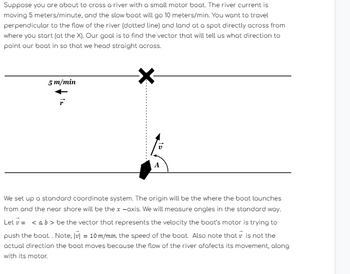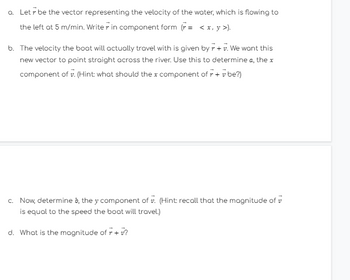Question
thumb_up100%
Complete only D

Transcribed Image Text:Suppose you are about to cross a river with a small motor boat. The river current is
moving 5 meters/minute, and the slow boat will go 10 meters/min. You want to travel
perpendicular to the flow of the river (dotted line) and land at a spot directly across from
where you start (at the X). Our goal is to find the vector that will tell us what direction to
point our boat in so that we head straight across.
5 m/min
We set up a standard coordinate system. The origin will be the where the boat launches
from and the near shore will be the x-axis. We will measure angles in the standard way.
Let v = < a, b > be the vector that represents the velocity the boat's motor is trying to
push the boat.. Note, v = 10 m/min, the speed of the boat. Also note that is not the
actual direction the boat moves because the flow of the river afafects its movement, along
with its motor.

Transcribed Image Text:a. Letr be the vector representing the velocity of the water, which is flowing to
the left at 5 m/min. Writer in component form (r= < x, y >).
b. The velocity the boat will actually travel with is given by + + v. We want this
new vector to point straight across the river. Use this to determine a, the x
component of v. (Hint: what should the x component of 7 + v be?)
c. Now, determine b, the y component of v. (Hint: recall that the magnitude of
is equal to the speed the boat will travel.)
d. What is the magnitude of r + v?
Expert Solution
This question has been solved!
Explore an expertly crafted, step-by-step solution for a thorough understanding of key concepts.
This is a popular solution
Trending nowThis is a popular solution!
Step by stepSolved in 3 steps with 1 images

Knowledge Booster
Similar questions
arrow_back_ios
arrow_forward_ios